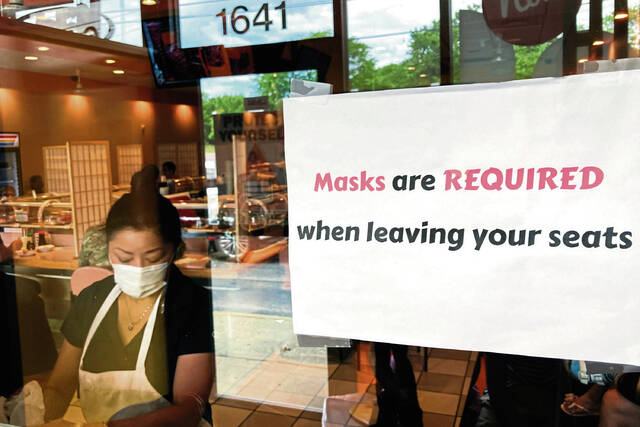https://triblive.com/business/small-businesses-navigate-ever-changing-covid-19-reality-2/
Small businesses navigate ever-changing covid-19 reality

NEW YORK — For a brief moment this summer, it seemed like small businesses might be getting a break from the relentless onslaught of the pandemic. More Americans, many of them vaccinated, flocked to restaurants and stores without needing to mask up or socially distance.
But then came a surge in cases caused by the delta variant, a push for vaccine mandates and a reluctant return to more covid-19 precautions. Now, small-business owners are left trying to strike a balance between staying safe and getting back to being fully open.
Navigating ever-changing coronavirus reality comes with a number of risks, from financial hardship to offending customers to straining workers. Those challenges could intensify as winter approaches and outdoor alternatives become limited. Still, small business owners say the whiplash is worth it to keep customers and employees as safe as possible.
“Just weeks ago, small- business owners hoped that a return to normalcy would help jump start our recovery,” said Jessica Johnson-Cope, chair of Goldman Sachs’ 10,000 Small Businesses Voices National Leadership Council and owner of a small business herself, Johnson Security Bureau in New York.
New York City ordered a vaccine mandate for customers in August. For Dan Rowe, CEO of Fransmart, which runs the Brooklyn Dumpling Shop, the mandate has been a financial burden and a headache. Brooklyn Dumpling Shop first opened in May and has six staffers. Its pandemic- friendly format is contactless and automated.
“It was engineered to be a restaurant with less employees,” Rowe said. Glass separates the kitchen and staff from customers, who order food from an app. When the kitchen is finished making the food, it’s placed in an automat-style window, so workers don’t come into contact with customers.
“We’ve engineered this great low labor restaurant, and the government is making us go backward,” he said.
Rowe had to hire another staffer to check vaccine cards at the door, increasing his overhead. His complaint is retail stores and groceries with prepared foods like Whole Foods don’t face the same restrictions.
“It’s not fair what’s going on and it’s not practical,” he said.
Although safety is the priority for everyone, the changes can be draining for owners and staff alike. Jennifer Williams, founder and CEO of closet organization company the Saint Louis Closet Co., said the company scrambled at first to implement a covid-19 plan, including masking and increased sanitization.
“We don’t have the option to ‘work from home.’ Our business happens in our manufacturing plant and in our clients’ homes, so we had to adjust quickly at the onset of the pandemic with covid precautions,” she said.
She nixed the mask requirement July 1, after her staff was fully vaccinated, covid-19 cases were declining and the CDC recommendations changed. But that was short-lived.
In early August, Missouri was one of the top three states for coronavirus cases. Williams re-implemented the mask mandate.
Williams’ staffers can spend up to eight hours a day in a mask installing closet organizing systems in a customer’s home. “The mental drain on employees has been extreme,” Williams said.
Jessica Benhaim, owner of Lumos Yoga & Barre, an independent fitness studio in Philadelphia, gradually increased size limits of classes from late spring into the summer, but capped them at 12, short of pre-pandemic levels of 18 students for yoga and 14 for barre.
Even though the city has lifted capacity restrictions, she’s keeping it capped in case restrictions come back. She lifted mask requirements for vaccinated students on June 15 but reinstated them when Philadelphia implemented a mask mandate in mid-August. Vaccinated students can remove their masks when they reach their mats.
“The constant adjustments over the last 18 months have been draining,” Benhaim said. “More than anything, it’s been stressful balancing making adjustments with trying to keep a sense of normalcy for my staff and clients.”
Copyright ©2025— Trib Total Media, LLC (TribLIVE.com)
